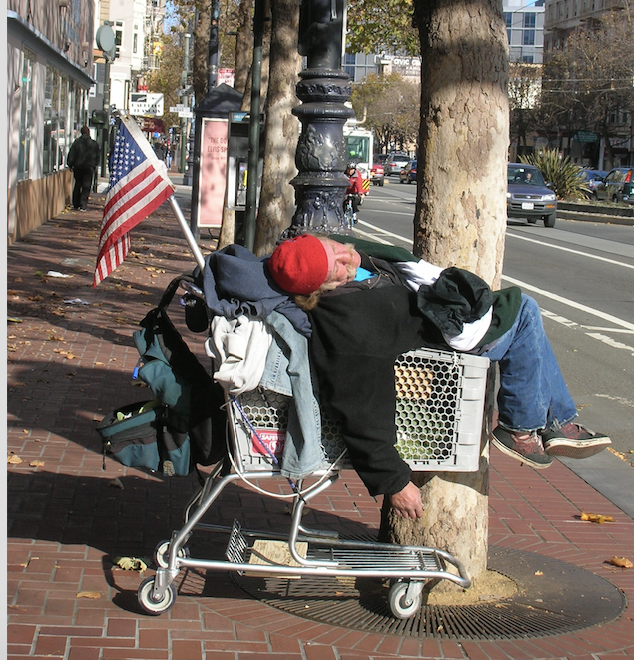It was early evening in San Jose and the darkness was just settling in for the night. I was on my way to a restaurant on the edge of the city’s Little Italy. To get there I had to walk beneath a highway overpass. In the shadows, homeless folks were curled tightly under blankets and cardboard. Some smoked and chatted. Some coughed and lazily looked up as I passed.
Earlier, scurrying between the venues of a science conference I was covering, I had seen others like them on the streets of the Silicon Valley city. They were Dickensian in their poverty. Arms and faces were smeared with dirt. Their shopping carts full of shredded bags and refuse. They shuffled, flinched and, at times, held out a wavering hand.
I saw still others in Palo Alto, so out of place in that town where the money comes off the street like a heat haze. It was as if they were time travellers dropped like soiled laundry on a sidewalk in a far distant utopia. They were clustered about the Caltrain station — arriving or departing. Constant motion, no rest.
Just up the street, past the airy crystal palace of a flagship Apple Store, a shared workspace sported tall ceilings and expansive pale wooden desks. The meeting rooms that skirted the space’s perimeter were partitioned off with ochre curtains filigreed with mashrabiya window motifs. With the sun pouring in, the occupants could have been looking out into a Cairo marketplace.
The space was called Hanahaus. So, at least the knowledge workers of Palo Alto had a place they could call home.
I saw the homeless as well in Mountain View, where beautiful youths ride free Google coloured bicycles between the vast network of the tech giant’s campuses.
Where coffee shops are populated by coders and graphic designers all huddled over laptops and shaping digital goods and services as real to them as shoes and wagon wheels. But, in reality, the manufacturing sector has fled the Valley and with it the need for the skills that fed the middle class here. The art of shaping atoms into objects has been supplanted by the ability to turn electrons into apps.
In the 60s and 70s Silicon Valley was a manufacturing hub. This is where Fairchild, Atari, AMD, Hewlett-Packard and Xerox all manufactured the electronics that changed the world. In that period, the county added over 200,000 manufacturing jobs. As those same companies embraced globalization and shifted work offshore, those local jobs drifted away like an unmoored container ship.
And that means that the sad folks I saw are just the lowest rung of the poverty ladder there. About 18 per cent of Santa Clara county’s population lives below that poverty line. Nearly 8,000 are homeless, including folks who work two jobs or teach university classes while living out of a car.
Rent starts at about $3,000 a month here, and a family budget needs to sit around $65,000 to cover this, which is almost three times the federal poverty level in the U.S. In short if you’re not in the tech sector, the economic disparity crushes you.
Santa Cruz dresses like a hippy and is the home of CrossFit. Palo Alto wears Warby Parker glasses and lays out a red carpet of mansions on the way into town. Mountain View is a Prisoner-like village that feels as manicured as Paris Hilton’s nails. But San Jose, on the edge of Silicon Valley, is a crumbling, often dirty and woebegone town that money forgot.
I went for a run along the Guadalupe River Trail there. The river was more of a dank water conduit surrounded by steep banks of brutalist concrete. It dispirited me to a standstill. I turned and walked back to my hotel.
On other runs, on all compass points from my hotel there were sorry shops, used-car lots, neglected homes and the frayed edges of an ignored infrastructure.
A programmer I met who lives on the edge of town told me that 10 years ago the park was a wonder, but there was no money to keep it up. “The rich live in gated communities and commute,” he said. “They don’t care about downtown.”
I saw a few of those gated communities on another run. Polished brass locks and keypads were everywhere. Wrought iron fences with spearhead posts guarded stuccoed manors and cloistered condos. They all seemed to have turned their backs on the city.
In many ways, San Jose is Silicon Valley’s street person.
Of course this disparity is little different in nature than that in any big city. Nobody gets to feel smug. But here it is amplified like a signal passed through a transistor. It is binary. On or off. It is code destined to crash and a mirror up to what happens when the lucky and ambitious are left to their own devices.
Image: Seguridad Social estadounidense/Javi/Flickr
Like this article? rabble is reader-supported journalism.




